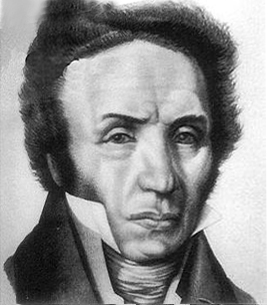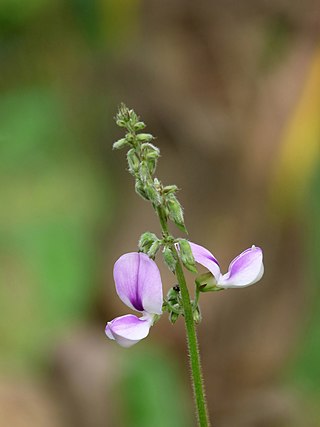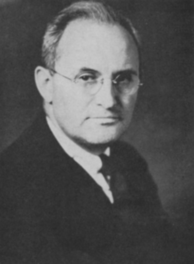
The American chestnut is a large, fast-growing deciduous tree of the beech family native to eastern North America. As is true of all species in genus Castanea, the American chestnut produces burred fruit with edible nuts. The American chestnut was one of the most important forest trees throughout its range.

The pathogenic fungus Cryphonectria parasitica is a member of the Ascomycota. This necrotrophic fungus is native to East Asia and South East Asia and was introduced into Europe and North America in the early 1900s. The fungus spread rapidly and caused significant tree loss in both regions.

André Michaux, also styled Andrew Michaud, was a French botanist and explorer. He is most noted for his study of North American flora. In addition Michaux collected specimens in England, Spain, France, and even Persia. His work was part of a larger European effort to gather knowledge about the natural world. Michaux's contributions include Histoire des chênes de l'Amérique and Flora Boreali-Americana which continued to be botanical references well into the 19th century. His son, François André Michaux, also became an authoritative botanist.

The bay-breasted warbler is a small species of songbird in the New World warbler family, Parulidae. It is one of thirty-four species in the diverse genus Setophaga. Like all songbirds, or passerines, the species is classified in the order Passeriformes.

Castanea sativa, the sweet chestnut, Spanish chestnut or just chestnut, is a species of tree in the family Fagaceae, native to Southern Europe and Asia Minor, and widely cultivated throughout the temperate world. A substantial, long-lived deciduous tree, it produces an edible seed, the chestnut, which has been used in cooking since ancient times.
The year 1788 in science and technology involved some significant events.

Pueraria is a genus of 15–20 species of legumes native to Asia. The best known member is kudzu, also called Japanese arrowroot. The genus is named after 19th century Swiss botanist Marc Nicolas Puerari.

Ruellia humilis is a species of flowering plant in the family Acanthaceae. It is native to the eastern United States. It is grown as an ornamental plant.

Solidago canadensis, known as Canada goldenrod or Canadian goldenrod, is an herbaceous perennial plant of the family Asteraceae. It is native to northeastern and north-central North America and often forms colonies of upright growing plants, with many small yellow flowers in a branching inflorescence held above the foliage. It is an invasive plant in other parts of the continent and several areas worldwide, including Europe and Asia. It is grown as an ornamental in flower gardens.

Eriocaulon decangulare, commonly known as ten-angled pipewort, hat pin and bog button, is a monocotyledonous plant native to the eastern United States, Mexico and Nicaragua. The plant's distribution is quite irregular, with several disjunct populations and a discontinuous primary range. Most of its habitat in the United States is found on the Atlantic Coastal Plain. It is found in areas of relatively low elevation and does not occur higher than 300 metres above sea level. This plant is found in peat and sand that is moist to wet, and is associated with savannahs, bogs, pinelands, ditches and the banks of cypress domes.
Hoverter and Sholl Box Huckleberry Natural Area is a 10-acre (4.0 ha) natural area in Perry County, Pennsylvania, near New Bloomfield, which protects a colony of box huckleberry over 1,000 years old. The smallest Natural Area in Pennsylvania, it is administered as part of Tuscarora State Forest. It was designated a National Natural Landmark in April 1967.

Earl Lemley Core was a botanist and botanical educator, researcher, and author as well as a local West Virginia historian. He was founder of the Southern Appalachian Botanical Club and editor of its journal, Castanea, for thirty-five years. He was a teacher and professor at West Virginia University (WVU) from 1928 to 1972. He served for four years on the Morgantown City Council, and served as mayor of Morgantown for two years. The Earl L. Core Arboretum at WVU was named in his honor in 1967.

Fimbristylis vahlii is a species of sedge known by the common name Vahl's fimbry. It is native to much of Central America and the southern half of North America, where it grows in wet habitat. This is a small, clumping sedge producing rounded stems just a few centimeters high surrounded by curling, thready leaves. At the top of the stem is an inflorescence which is a cluster of several cylindrical, pointed spikelets surrounded by long, narrow, twisting bracts. The fruit is a tiny achene about half a millimeter wide.
The Southern Appalachian Botanical Society is an American botanical society formed in 1935 at West Virginia University. The focus of the society has gradually changed and now includes the botany of the entire eastern United States, including the taxonomy, biogeography, ecology, physiology, and biochemistry of plants. The society has about 500 members.
Anna Rosina Kliest Gambold was an American Moravian missionary and diarist.

Castanea ozarkensis, also known as the Ozark chinkapin, is a species of tree that is native to the United States. It is in the Castanea genus that includes chestnuts and types of chestnut known as chinkapins.

Asimina reticulata, the netted pawpaw, is a species of plant in the family Annonaceae. It is native to Florida in the United States.

Elizabeth Ann Bartholomew was an American botanist dedicated to the study of plant systematics. The standard author abbreviation E.A.Barthol. is used to indicate this person as the author when citing a botanical name.

Perry Daniel Strausbaugh was an American botanist and expert in the flora of West Virginia. The standard author abbreviation Strausb. is used to indicate this person as the author when citing a botanical name.

Clinopodium talladeganum, commonly known as the Talladega wild basil, is a perennial vascular shrub in the mint family. C. talladeganum is endemic to a small area in three counties of Alabama.















